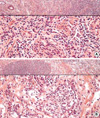Abstract
A 30-yr-old man was referred for suspicious rectal cancer because of ulcerated lesions in the rectum and a palpable mass in left inguinal area. Sigmoidoscopy showed two indurated masses and histologic evaluation of biopsy revealed obliterative endarteritis with heavy plasma cell infiltration. Both venereal disease research laboratories (VDRL) and fluorescent treponemal antibody absorption (FTA-ABS) tests were positive. After injection of penicillin G benzathine for 3 weeks, the rectal chancre and the palpable mass disappeared.
The prevalence of syphilis in the normal population has decreased significantly since 1977 in Korea (1, 2). However, in Western countries the incidence of syphilis has risen, mainly in the 20-24 age group and its clinical manifestations have been various (3). Sexual activity has become more acceptable in our culture recently, initiating various forms of sex, and as a result, many different clinical conditions of sexually transmitted disease (STD) have appeared.
Primary rectal syphilis is a rare disease. It is usually asymptomatic and less frequently presents as proctitis, ulcer and pseudotumors (3, 4). Therefore, it is difficult to diagnose and physicians occasionally might prescribe inappropriate treatments (5, 6). In this paper we describe a case of primary rectal syphilis which was suspected to be rectal cancer.
A 30-yr-old man was referred to our hospital for suspected rectal cancer. He complained of bowel habit change with tenesmus, mucous discharge, anal pain and intermittent presence of blood in stool. He had a 2 cm sized, firm, non-tender and indurated nodule on the left side of the inguinal area and multiple condyloma acuminatum around the anus. Routine blood chemistry was normal. Sigmoidoscopy in our gastrointestinal endoscopy unit showed two indurated masses of 1.5 to 2 cm on the posterior wall of the middle and lower rectum (Fig. 1A). The masses had a coin like appearance, and each of them had a slightly depressed and ulcerated surface. Owing to the suspected submucosal tumor, the coloproctologist obtained a biopsy specimen. Histologic findings of rectal biopsy showed heavy lymphoid hyperplasia without neoplastic changes (Fig. 2A). Additional histologic findings of the left inguinal mass were the same (Fig. 2B). The pathologist recommended evaluation for STD because pathologic findings were not malignancy but inflammation. So the patient was referred to the urology department. The VDRL quantitative test was 1:64 and the FTA-ABS IgM and IgG test was positive. A human immunodeficiency virus (HIV) antibody test was negative. Further questioning also revealed an episode of rectal intercourse before the onset of symptoms. The patient was treated with intramuscular penicillin G benzathine (2,400,000 IU IM/1 week, thrice). Follow-up sigmoidoscopy after 1 month showed nearly complete regression of the chancre (Fig. 1B). A repeat biopsy was done and the histologic result showed focal lymphoid hyperplasia. A VDRL quantitative test after 3 months was 1:1. The palpable nodule on the left inguinal area disappeared.
Rectal chancre is an unusual case, especially in Korea. Most physicians have a tendency to consider rectal ulceration as a neoplasm (7, 8). Similarly in our case symptoms and signs suggested rectal neoplasia and the clinical history did not reveal homosexuality. However, after the VDRL test the patient confessed that he had been raped by a homosexual male. Therefore, when rectal syphilis is suspected (i.e., perianal condyloma acuminatum associated with inguinal lymphadenopathy) the history of sexual intercourse, especially rectal intercourse, has to be taken.
A positive VDRL test is not diagnostic because it is nonspecific. A dark-field examination is recommended by many studies (3). In our case, however, a dark-field examination was not performed, because rectal chancre was highly suggested by the clinical history, anorectal lesions, pathologic findings and positive serologic test. Additionally, like other syphilis cases benzathine penicillin therapy induced a rapid regression of the rectal lesions. We believe when a positive serologic syphilis test is associated with ulcerative lesion, additional laboratory tests are not necessary.
Inguinal lymphadenopathy need not require an initial biopsy when evidence of regional infection is present. Usually after antibiotic therapy of at least 4 weeks, most physicians might decide whether a biopsy is necessary. In this case, however, the physician did not have experience recognizing rectal syphilis, so he immediately obtained a biopsy specimen from the inguinal lesion. We think that this is an unnecessary procedure.
In western countries the incidence of rectal syphilis is rising, especially in groups of active homosexual males. Bassi et al. emphasized in his case report that endoscopists should keep in mind the rising incidence of syphilis (3). Therefore syphilis should be considered whenever anorectal lesions are found. Sexual history is also important. Active homosexual male have a tendency to conceal sexual history from a physician. Moreover a patient raped by a homosexual male wants to hide the accident. Therefore an initial physician should encourage his/her patient to inform him/her of the patient's sexual history.
Figures and Tables
References
1. Kim YA, Lee JB, Lee MG. Recent trends of syphilis prevalence in normal population in Korea-1986. J Korean Med Sci. 1988. 3:13–17.

2. Cho TH, Kim HO, Lee JB, Lee MG. Syphilis prevalence has rapidly decreased in South Korea. Sex Transm Infect. 2003. 79:323–324.

3. Bassi O, Cosa G, Colavolpe A, Argentieri R. Primary syphilis of the rectum-endoscopic and clinical features. Report of a case. Dis Colon Rectum. 1991. 34:1024–1026.
5. Quinn TC, Lukehart SA, Goodell S, Mkrtichian E, Schuffler MD, Holmes KK. Rectal mass caused by Treponema pallidum: confirmation by immunofluorescent staining. Gastroenterology. 1982. 82:135–139.

6. Drusin LM, Homan WP, Dineen P. The role of surgery in primary syphilis of the anus. Ann Surg. 1976. 184:65–67.

8. Voicchet O, Guivach M. Chancre syphilitique simulant un cancer du rectum. Gastroenterol Clin Biol. 1980. 4:134–136.




 PDF
PDF ePub
ePub Citation
Citation Print
Print




 XML Download
XML Download